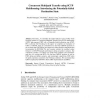Free Online Productivity Tools
i2Speak
i2Symbol
i2OCR
iTex2Img
iWeb2Print
iWeb2Shot
i2Type
iPdf2Split
iPdf2Merge
i2Bopomofo
i2Arabic
i2Style
i2Image
i2PDF
iLatex2Rtf
Sci2ools
NETWORKING
2008
2008
Concurrent Multipath Transfer Using SCTP Multihoming: Introducing the Potentially-Failed Destination State
Previously, we identified the failure-induced receive buffer (rbuf) blocking problem in Concurrent Multipath Transfer using SCTP multihoming (CMT), and proposed CMT with a Potentially-failed destination state (CMTPF) to alleviate rbuf blocking. In this paper, we complete our evaluation of CMT vs. CMT-PF. Using ns-2 simulations we show that CMT-PF performs on par or better than CMT during more aggressive failure detection thresholds than recommended by RFC4960. We also examine whether the modified sender behavior in CMT-PF degrades performance during non-failure scenarios. Our evaluations consider: (i) realistic loss model with symmetric and asymmetric path loss, (ii) varying path RTTs. We find that CMT-PF performs as well as CMT during non-failure scenarios, and interestingly, outperforms CMT when the paths experience asymmetric rbuf blocking conditions. We recommend that CMT be replaced by CMT-PF in future CMT implementations and RFCs1 .
Better Than Cmt | Computer Networks | Future Cmt Implementations | NETWORKING 2008 | Rbuf Blocking Conditions |
| Added | 29 Oct 2010 |
| Updated | 29 Oct 2010 |
| Type | Conference |
| Year | 2008 |
| Where | NETWORKING |
| Authors | Preethi Natarajan, Nasif Ekiz, Paul D. Amer, Janardhan R. Iyengar, Randall R. Stewart |
Comments (0)

